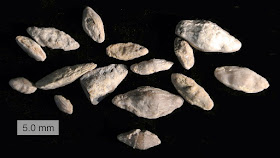An extraterrestrial empanada. . . A space ravioli. . . A planetary baguette. Some of Saturn’s moons have shapes that are strangely reminiscent of culinary creations.
Images of the oddly-shaped moons, mostly from now-defunct Cassini spacecraft, got planetary scientists wondering how these satellites ended up with such strange shapes. Now, researchers suggest that collisions between moonlets could account for these shapes according to a study published online today, May 21, 2018, in Nature Astronomy. {The original Nature article includes some of these space culinary terms.}
Dr. Adrien Leleu , a planetary scientist at the University of Bern in Switzerland, and colleagues developed computer simulations that let the scientists virtually smack together similar-sized moonlets at various speeds and angles. The team found that, at low angles and relative speeds of tens of meters per second (roughly equal to a car traveling on country roads), impacts can create offbeat shapes that look like the misfits around Saturn.
Head-on collisions result in a flattened moon like Pan, which resembles an extraterrestrial empanada. An impact angle of just a few degrees leads to an elongated satellite such as Prometheus, which looks like a French baguette.
Not all run-ins create a weird-looking moon. At higher angles, for example, moonlets might "hit and run." Or they could form highly elongated rotating moons that subsequently break apart.
Dr. Leleu and collaborators focused on the smaller moons of Saturn that orbit within the planet’s rings. But the team also found that a similar collision between two larger moonlets could also account for the odd shape of Iapetus, a more distant walnut-shaped moon with a pronounced ridge along its equator that has puzzled scientists since the belt’s discovery. Other speculative origins for the ridge include volcanoes, plate tectonics or ring debris that rained down on the moon.
I will admit that I was drawn to the odd shapes of possible moonlets because they reminded me of images of fossils like fusulinids (see below). Nature likes reusing cool shapes, I suppose.
Enjoy this planetary patisserie!
Steph
Enjoy this planetary patisserie!
Steph








Now I'm hungry; any of these moons made of green cheese?
ReplyDeleteI suppose it is human nature to relate any shape to what we know or want - you see a fusulinid, a botanist might see a seed shape, a urologist might have fond memories of kidney stones she has known.
Prometheus reminds me of the interior space of the main crematorium chapel at Skogskyrkogården in Stockholm (translates to Woodland Cemetery, but the Swedish is pretty cool once you figure it out).
ecoA+, it makes sense that an architect would be tuned into shape and space. The interior space of the crematorium is quite intriguing, perhaps a bit womb-like. Coming and going from a similarly-space could be comforting, I'd imagine. Thanks for the link.
DeleteExcellent observation, WW++, I (and others) have felt exactly that about the space. I don't know if that was the architect's intended metaphor.
DeleteNo, eco, only our moon is made of green cheese.
ReplyDeleteGood thing we have a donut-shaped universe.
DeleteBoth oldies but goodies (literally).
DeleteBut what are we made of?
ReplyDeleteI remember Solyent Green having a profound effect on my friends and me. Thanks for the reminder, Paul.
DeleteI still refuse to eat food that comes in compressed bar shapes. Except chocolate, of course.
DeleteSpoiler Alert: friends don't appreciate when I yell "Clifbar is people."
I used to be a vegetarian, and only ate plants. Now, I'm a humanitarian...
DeleteDo you go to canny balls?
DeleteOh, karst, that’s too good! Drain the swamp!
ReplyDeleteAncient Rome's economy revealed in Greenland ice sheet cores.
ReplyDeleteLead leads the way.
DeletePlumbing punning's depths?
DeleteWith Pb & j sandwiches served?
DeleteSpeaking of which, I noticed you used the word "plumbago" over at Blaine's the other day. I'd never heard that term before Jeopardy last week. You?
DeleteNo, that was the also first I'd heard of plumbago in terms of an archaic version of graphite.
DeleteI have heard of the plant, plumbago, though.
Spell check is none too happy with plumbago either.
The Silence of the Bugs
ReplyDeleteNew post on "'Opposite Birds:' Why Being Grounded May Have Been the Counterintuitive Key to Survival" is now up.
ReplyDelete